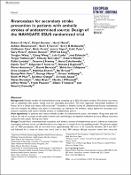Background: Embolic strokes of undetermined source comprise up to 20% of ischemic strokes. The stroke recurrence rate is substantial with aspirin, widely used for secondary prevention. The New Approach riVaroxaban Inhibition of Factor Xa in a Global trial versus ASA to prevenT Embolism in Embolic...
Selecciona los documentos para visualizarlos
| Nombre del archivo | Ver recurso |
|---|













